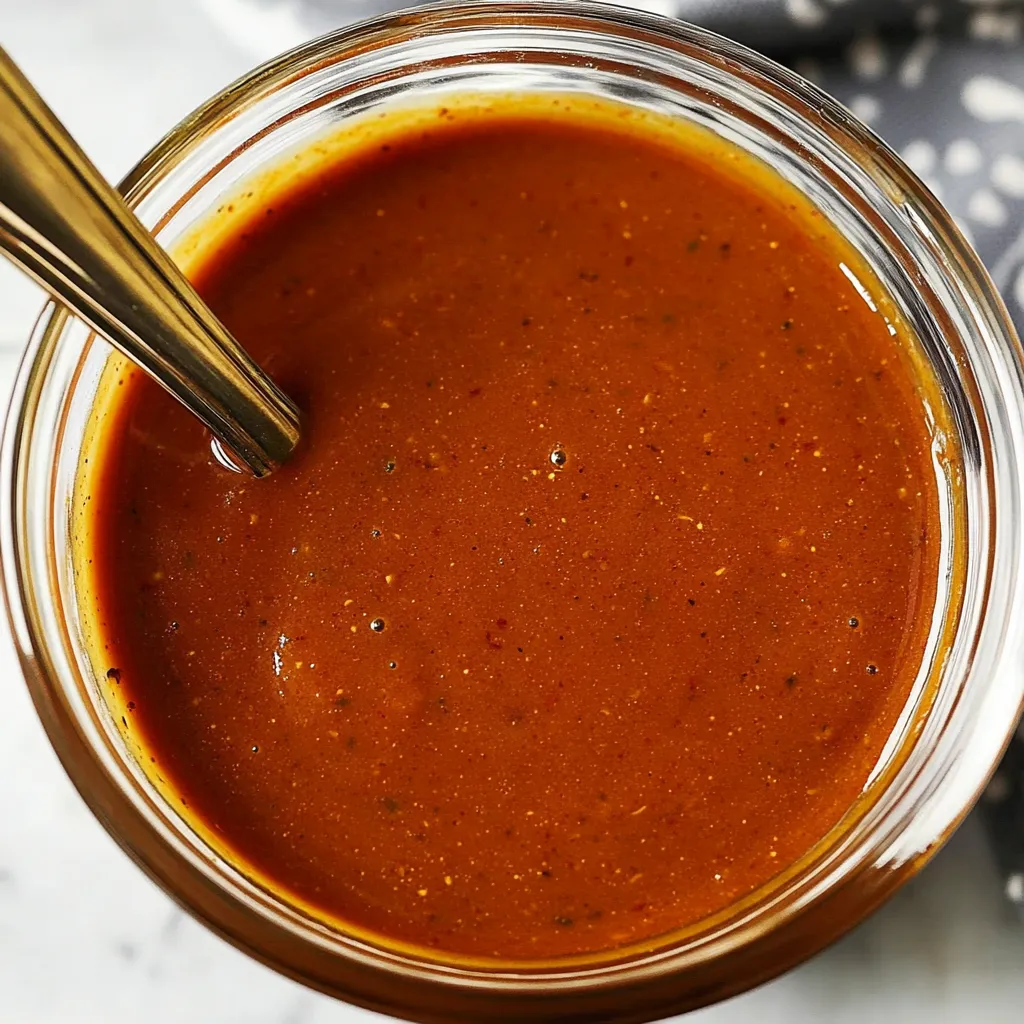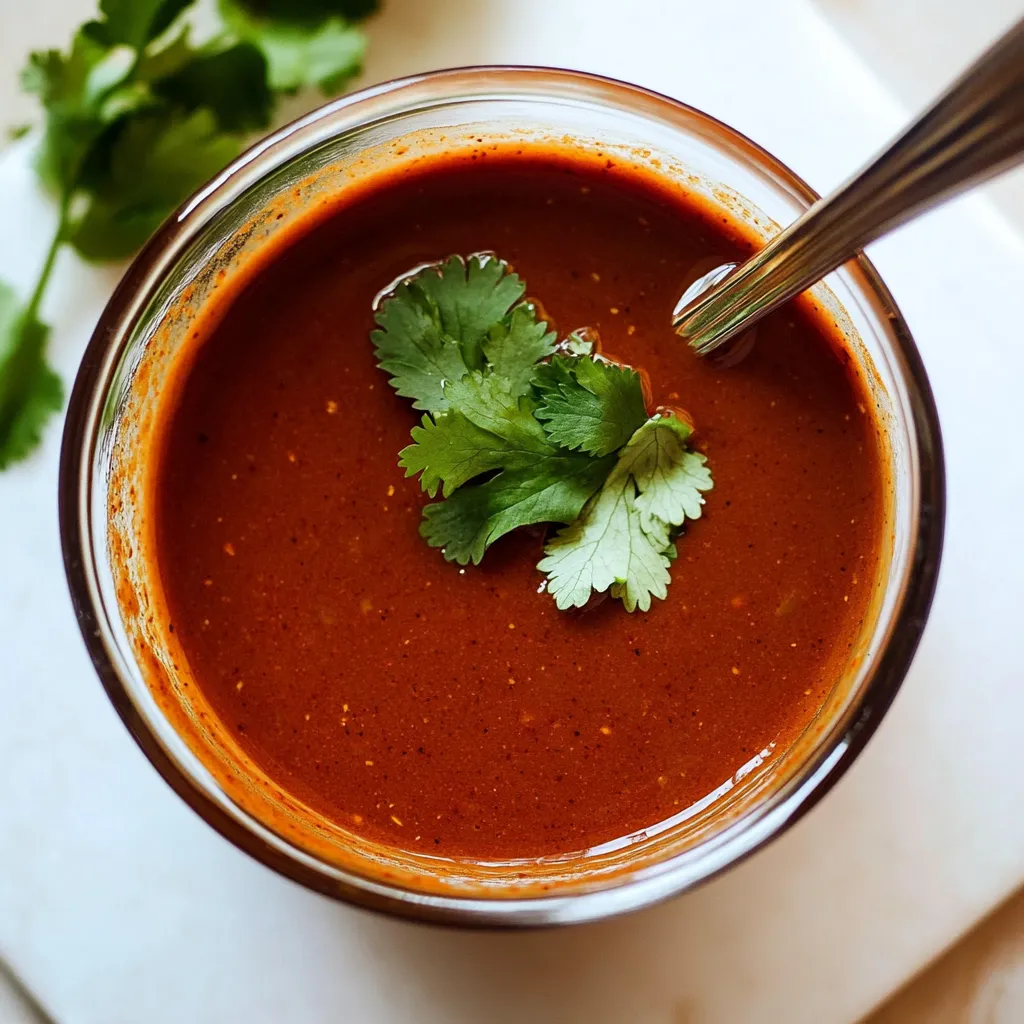 Pin it
Pin it
This deeply flavorful homemade enchilada sauce transforms simple pantry ingredients into something that tastes infinitely better than anything you can buy in a can. The combination of tomato sauce, warm spices, and a perfectly balanced roux creates a rich, velvety sauce with layers of smoky, earthy, and tangy flavors that make every enchilada taste restaurant-quality. Unlike store-bought versions that often taste flat or overly processed, this homemade sauce delivers authentic Mexican flavors in just minutes using ingredients you probably already have in your kitchen.
I started making this sauce when I realized how much better my enchiladas could taste with just a little extra effort in the sauce department. The first time I served enchiladas made with this homemade sauce instead of canned, my family immediately noticed the difference - the flavors were so much more vibrant and complex, and I loved knowing exactly what went into our dinner.
Essential Ingredients and Selection Tips
- Quality tomato sauce: Choose smooth, plain tomato sauce without added seasonings; look for brands with minimal ingredients and no added sugar
- Avocado oil: The neutral flavor won't compete with the spices; olive oil works as a substitute but may add slight fruitiness
- All-purpose flour: Fresh flour creates the smoothest roux; old flour can have off flavors that affect the final sauce taste
- Chili powder: This is the star ingredient, so choose a high-quality blend or make your own; taste it first to gauge heat level and adjust accordingly
- Ground cumin: Use cumin that's still aromatic and vibrant; old, stale cumin won't contribute the earthy depth this sauce needs
- Garlic powder: Granulated works better than garlic salt for controlling sodium; fresh garlic would burn during the cooking process
- Dried oregano: Mexican oregano provides more authentic flavor than regular oregano if you can find it
- Vegetable broth: Low-sodium varieties give you better control over the final saltiness; chicken broth can be substituted for deeper flavor
The secret to smooth, lump-free enchilada sauce is whisking constantly while gradually adding the liquids and cooking the roux properly to eliminate any raw flour taste.
Detailed Step-by-Step Instructions
- Step 1: Heat the oil properly:
- Pour the avocado oil into a small, heavy-bottomed saucepan and heat over medium heat until it shimmers but doesn't smoke. The right temperature is crucial for creating a proper roux without burning the flour.
- Step 2: Create the roux base:
- Sprinkle the flour evenly over the hot oil and whisk immediately and continuously for exactly 1 minute. The mixture should bubble gently and become smooth and paste-like without browning - this cooks out the raw flour taste while creating the thickening base.
- Step 3: Bloom the spices:
- Add the chili powder, cumin, garlic powder, and dried oregano to the flour mixture and whisk constantly for another full minute. This blooming process releases the spices' essential oils and deepens their flavors significantly, creating the aromatic foundation of your sauce.
- Step 4: Add liquids gradually:
- Very slowly pour in the tomato sauce while whisking continuously - start with just a splash, whisk until smooth, then continue adding in a thin, steady stream. This prevents lumps from forming and ensures the roux incorporates smoothly into the liquid.
- Step 5: Incorporate the broth:
- Continue the same gradual process with the vegetable broth, adding it slowly while whisking constantly. The mixture will be quite thin at first but will thicken as it cooks, so don't worry if it seems too liquidy initially.
- Step 6: Simmer to perfection:
- Bring the sauce to a gentle simmer over medium heat, then reduce heat to medium-low and cook for 10-12 minutes, stirring frequently to prevent sticking. The sauce is ready when it coats the back of a spoon and has reduced slightly in volume.
- Step 7: Season and adjust:
- Remove from heat and season with sea salt to taste, starting with ½ teaspoon and adding more as needed. Taste and adjust the spice level - add more chili powder for heat or a pinch of sugar if the tomatoes are too acidic.
- Step 8: Final texture check:
- The sauce should be smooth, thick enough to coat food but thin enough to pour easily. If it's too thick, whisk in a little more broth; if too thin, simmer uncovered for a few more minutes to reduce.
 Pin it
Pin it
The most critical technique is maintaining constant whisking motion while adding liquids and keeping the heat at the right level to prevent the roux from burning or the sauce from developing lumps.
This enchilada sauce recipe has become my proof that homemade doesn't have to mean complicated - sometimes the simplest techniques produce the most dramatic improvements in flavor. My mother-in-law, who's quite particular about Mexican food authenticity, was impressed that something so straightforward could taste so much better than what we'd been buying at the store.
Understanding Roux Science and Thickening Mechanisms
The roux technique used in this sauce is fundamental to creating smooth, well-thickened sauces without lumps or raw flour taste. When flour is cooked in fat, the starch granules swell and the proteins develop, creating a thickening agent that works much more effectively than simply stirring flour into liquid. The one-minute cooking time is specifically calculated to cook out the raw flour taste while preventing browning that would darken the sauce. This technique creates a stable base that can hold the sauce together even when reheated multiple times.
Spice Blooming and Flavor Development
Cooking the spices in oil after the roux formation is a crucial step that dramatically enhances their flavor impact. This blooming process releases volatile oils and compounds that remain locked in dried spices until activated by heat and fat. Chili powder, cumin, and oregano all contain oil-soluble flavor compounds that become much more aromatic and complex when properly bloomed. The timing is important - too short and the spices won't fully develop, too long and they can become bitter or burned.
Liquid Integration and Texture Control
The gradual addition of liquids while whisking constantly is essential for preventing lumps and creating the smoothest possible texture. Adding all the liquid at once would cause the roux to seize up and form clumps that are nearly impossible to smooth out. The slow incorporation allows the roux to gradually loosen and accept the liquid while maintaining its thickening properties. The sauce continues to thicken during the simmering process as starches fully hydrate and the liquid reduces slightly.
Heat Management and Consistency Development
Proper heat control throughout the cooking process ensures optimal flavor development without burning or scorching. Medium heat for the roux prevents browning while ensuring proper cooking, while the gentle simmer that follows allows flavors to meld and the sauce to reach proper consistency. The sauce will continue to thicken slightly as it cools, so it should be just slightly thinner than desired when hot. Understanding this allows you to achieve perfect consistency for coating and serving.
Storage and Make-Ahead Benefits
This enchilada sauce actually improves in flavor when stored, as the spices continue to meld and develop complexity over time. Proper storage in an airtight container prevents a skin from forming on top while maintaining freshness. The sauce can be made up to five days ahead, making it perfect for meal planning and quick weeknight dinners. When reheating, gentle heat and occasional stirring prevent separation while restoring the original smooth consistency.
This enchilada sauce has taught me that some of the most impactful improvements in home cooking come from mastering simple, fundamental techniques rather than seeking out exotic ingredients. Every time I make it, I'm reminded that understanding the science behind cooking methods allows you to create consistently excellent results while building confidence that leads to more adventurous cooking.
Frequently Asked Questions
- → How long does homemade enchilada sauce last?
- Store it in the fridge for up to one week in a covered container.
- → Can I make this sauce spicier?
- Yes, just add more chili powder or throw in some cayenne pepper to taste.
- → What can I use instead of avocado oil?
- You can use vegetable oil, canola oil, or even olive oil instead.
- → Why is my sauce too thin?
- Let it simmer longer to thicken up, or it will get thicker as it cools down.
- → Can I freeze leftover enchilada sauce?
- Yes, freeze it for up to 3 months in freezer bags or containers.
- → Do I need to use vegetable broth?
- You can use chicken broth or even water, but vegetable broth adds more flavor.
